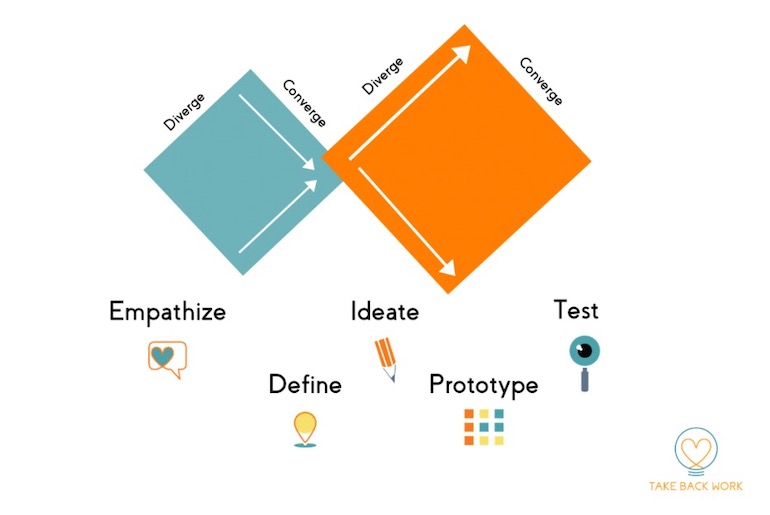7 minutes
This five-step process can boost your innovation.
This blog was reprinted with permission from the original.
Eternally optimistic, but perpetually dissatisfied—that’s how we describe ourselves at Take Back Work. We know that things can be better, and we believe that it’s possible. That’s why design thinking and human-centered design tie into almost everything we do, from writing up client proposals to planning culture change strategies.
People often ask us what design thinking is or how to learn more—so here’s our version of a crash course in design thinking to get you started!
Personally, my journey with design thinking began back in 2013. I’d heard the phrase mentioned in books, but things really clicked when I watched this 60 Minutes feature with David Kelley, who founded the global innovation firm IDEO as well as the Hasso Plattner Institute of Design at Stanford University, fondly called the “d.school.”
I was serving in the Air Force at the time, and there were countless opportunities to make processes and procedures more “people-friendly.” Hungry to learn more, I poured over the online resources at Stanford’s d.school website and, along with some of my teammates, designed a process to match Airmen innovators with mentors and resources to bring their ideas to life.
The experience was so rewarding that I began to dream about attending the d.school one day. With a lot of hard work and some crazy luck, I made my way into Stanford’s MBA program and fulfilled my bucket-list item of taking classes at the d.school!
What Is Design Thinking?
First and foremost, design thinking is a problem-solving methodology that helps generate innovative solutions by following a five-step process (we’ll dive into that more deeply below). Some examples include adapting to a changing market, identifying a new business model, improving an existing product and creating new value. It’s also especially helpful as a framework to gather and make sense of diverse perspectives—that’s what makes it well-suited to use in the context of workplace culture.
As you develop your design thinking expertise, you’ll probably notice that it transforms from a simple process into a mindset. Instead of becoming frustrated by poorly designed processes, or feeling helpless as friends, relative, and colleagues complain about an experience, you’ll start paying attention with an eye towards how this data can lead to innovations and improvements.
What Makes Design Thinking Different?
Unlike other methodologies, design thinking is human-centered. This means that people are the focus, from initial interviews that get to the heart of the matter to seeking feedback on prototypes and all stages in between. Empathy for the user is the starting point. It doesn’t matter if you design a product, service or process—the final result is an improvement to the human experience.
Sometimes you’ll hear people use the term human-centered design, too. These concepts are very closely related, but design thinking covers the entire process of designing something innovative that’s informed by human input, whereas human-centered design describes the specifics of making a product or service more people-friendly.
Design Thinking in Action
You’re probably curious about tangible examples of design thinking in action by this point. The good news is that many products and services you’re already familiar with have been developed or improved using the design thinking methodology. Here are a few:
- Automatic external defibrillator: A life-saving device that walks you through the process by talking to you.
- boston.gov: A citizen-centered website for the city of Boston
- Opera for a younger crowd: A lively experience to grow the next generation of opera fans for the San Francisco Opera
- D.light: Affordable LED lighting for those without access to electricity
Hopefully, you found something inspiring in one of those examples, something that resonates with you. Ready to dig in?
The Design Thinking Process
There are five steps to the design thinking process: empathize, define, ideate, prototype and test. You’ll also notice in the image that there is a cycle of diverging or expanding knowledge and insight, followed by converging or narrowing down of the focus. This structure gives us space to be creative but then helps us convert that creativity into meaningful outcomes.

Here’s a more detailed overview of the five steps:
- Empathize. Before leaping to conclusions about what will work, we take time to observe and interview real people, gaining powerful insight into pain points and concerns. By putting our currently held beliefs aside and engaging as an anthropologist would, we channel curiosity and open-mindedness that allows us to see each situation through fresh eyes. Gathering diverse experiences and perspectives helps us uncover new possibilities.
Major “aha!” moment: In my opinion, this is the most important step in design thinking. Without it, we’re strictly relying on our own experiences to understand the situation.
- Define. In this stage, we take time to re-evaluate the original problem statement with the new insights gleaned from the empathize step. It’s not uncommon to generate powerful reframes that point us in a new direction. We also take time to get the wording just right, because the tone and nuance of the problem statement sets the stage for brainstorming solutions. One example: Most problem statements will start with the phrase “How might we…?” This specific wording prepares us for the ideate step by helping us let go of the “coulds” and “shoulds” that constrain our thinking.
Major “aha!” moment: Expect that you will have to make adjustments to your initial problem statement. It’s tempting to quickly focus on what you think the problem is, but there’s likely a more intriguing challenge behind that one!
- Ideate. Once you have fine-tuned your problem statement, it’s time to ideate! This step is full of high-energy brainstorming that yields dozens of ideas. Then, we use a variety of idea selection techniques to narrow down which idea we’d like to prototype.
Major “aha!” moment: The best and most productive brainstorming sessions have a few rules to ensure things go smoothly. Some of my favorite rules include “defer judgment” and “go for quantity.” Ideation is about coming up with lots of ideas (even wacky ones!) that might lead to breakthroughs. If you start considering feasibility, you’ve limited yourself. One strategy is to set a stretch goal to come up with 50+ ideas so that you’re forced to push beyond what first comes to mind.
- Prototype. Prototyping is a quick way to test out an idea. It gives your potential users something to react to so that you can rapidly (and cheaply) assess your product or service, making tweaks as necessary. And if you do have to scrap the entire idea, you won’t have spent a tremendous amount of time or money! You’ll just prototype again until you have something worthy of testing.
Major “aha!” moment: There are many different types of prototypes you can use to test an idea using very few resources. For example, if your idea is a new app, you don’t have to actually build the app—you can draw it out on paper and have people test this version before you spend a single cent on development.
- Test. The final step in the design thinking loop is about putting your product or service out there once you’ve developed a promising prototype. While there will still be changes and iterations, most of the friction points were ironed out in the prototyping step so you’re more likely to gain traction and acceptance from the end-user.
Major “aha!” moment: When you go through the steps of design thinking, you might find that you’ve created something that addresses a strong need of a very vocal or “extreme” user. This can seem a bit counterintuitive, as other methods of development tend to focus on the needs of the majority. But it is better to have a small contingent of dedicated and wildly happy customers than a large group who doesn’t see the need for the product or service you have created.
So there you have it—a crash course in design thinking!
Clearly, there’s much more to be shared, and design thinking is best learned through experiencing it. But we hope this gives you just enough context to pique your curiosity and desire to learn more.
As the CEO and founder of Take Back Work, Valerie Rivera is on a mission to help organizations create workplace cultures where people thrive. Above all, she loves the thrill of seeing people come to life at work – with renewed purpose, engagement, and initiative. She incorporates best practices in organizational behavior, design thinking and coaching for change that sticks. She partners with clients to develop practical strategies tailored to their needs.





